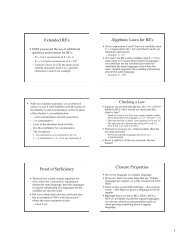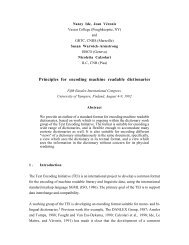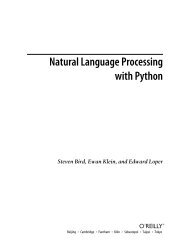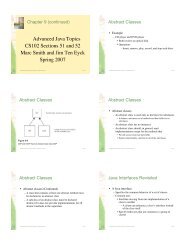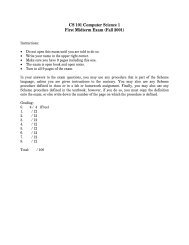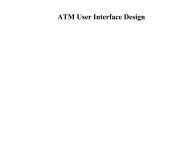Chapter 4 Data Abstraction: The Walls Abstract Data Types Abstract ...
Chapter 4 Data Abstraction: The Walls Abstract Data Types Abstract ...
Chapter 4 Data Abstraction: The Walls Abstract Data Types Abstract ...
You also want an ePaper? Increase the reach of your titles
YUMPU automatically turns print PDFs into web optimized ePapers that Google loves.
<strong>Chapter</strong> 4<strong>Abstract</strong> <strong>Data</strong> <strong>Types</strong><strong>Data</strong> <strong><strong>Abstract</strong>ion</strong>: <strong>The</strong> <strong>Walls</strong>Figure 4-1Isolated tasks: the implementation of task T does not affect task Q© 2006 Pearson Addison-Wesley. All rights reserved 4-1© 2006 Pearson Addison-Wesley. All rights reserved 4-2<strong>Abstract</strong> <strong>Data</strong> <strong>Types</strong>• <strong>The</strong> isolation of modules is not total– Methods’ specifications, or contracts, govern how they interactwith each other<strong>Abstract</strong> <strong>Data</strong> <strong>Types</strong>• <strong>Abstract</strong> data type (ADT)– An ADT is composed of• A collection of data• A set of operations on that data– Specifications of an ADT indicate• What the ADT operations do, not how to implementthem– Implementation of an ADT• Includes choosing a particular data structureFigure 4-2A slit in the wall© 2006 Pearson Addison-Wesley. All rights reserved 4-3© 2006 Pearson Addison-Wesley. All rights reserved 4-4<strong>Abstract</strong> <strong>Data</strong> <strong>Types</strong><strong>Abstract</strong> <strong>Data</strong> <strong>Types</strong>• <strong>Data</strong> structure– A construct that is defined within a programminglanguage to store a collection of data– Example: arrays• ADTs and data structures are not the same• <strong>Data</strong> abstraction– Results in a wall of ADT operations between datastructures and the program that accesses the data withinthese data structures© 2006 Pearson Addison-Wesley. All rights reserved 4-5Figure 4-4A wall of ADT operations isolates a data structure from the program that uses it© 2006 Pearson Addison-Wesley. All rights reserved 4-6
Specifying ADTsImplementing ADTs• In a list– Except for the first and lastitems, each item has• A unique predecessor• A unique successor– Head or front• Does not have a predecessor– Tail or end• Does not have a successorFigure 4-5A grocery list© 2006 Pearson Addison-Wesley. All rights reserved 4-7Figure 4-8ADT operations provide access to a data structure© 2006 Pearson Addison-Wesley. All rights reserved 4-8Implementing ADTsJava Classes RevisitedFigure 4-10An object’s data andmethods are encapsulatedFigure 4-9Violating the wall of ADT operations© 2006 Pearson Addison-Wesley. All rights reserved 4-9© 2006 Pearson Addison-Wesley. All rights reserved 4-10An Array-Based Implementationof the ADT ListAn Array-Based Implementationof the ADT List• An array-based implementation– A list’s items are stored in an array items– A natural choice• Both an array and a list identify their items bynumber– A list’s k th item will be stored in items[k-1]Figure 4-11An array-based implementation of the ADT list© 2006 Pearson Addison-Wesley. All rights reserved 4-11© 2006 Pearson Addison-Wesley. All rights reserved 4-12



